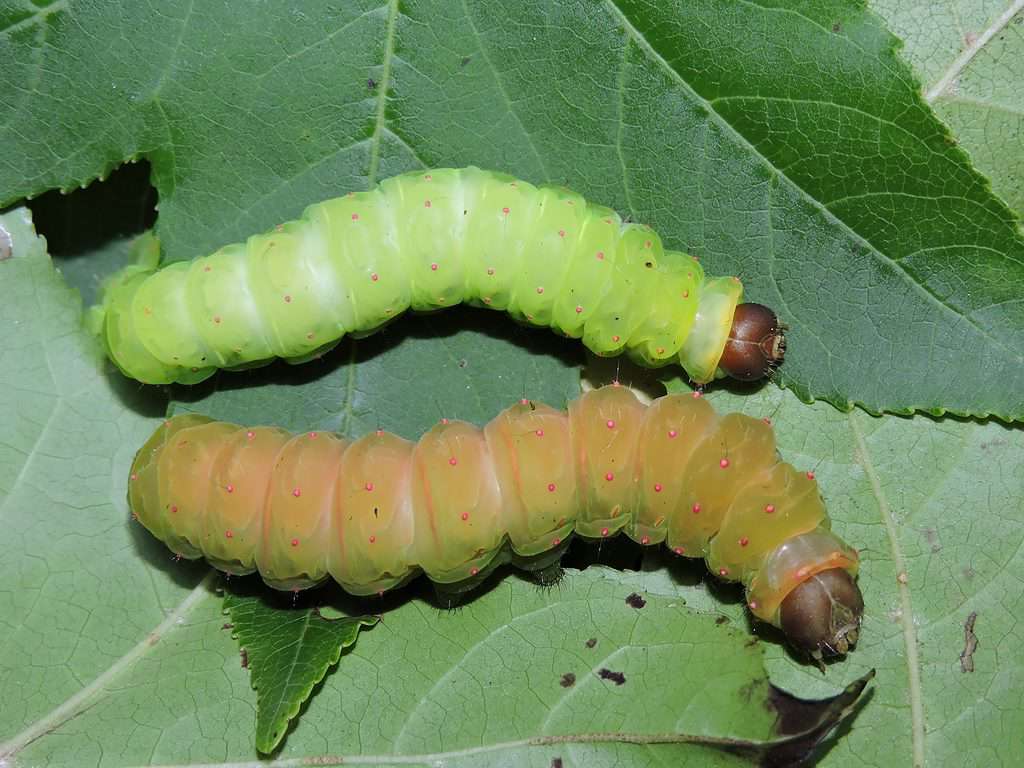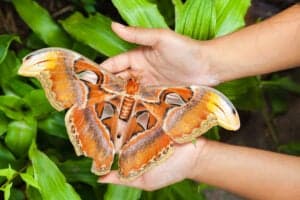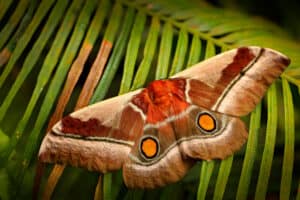Luna moths are one of the largest moth species in the United States, but did you know that fully grown adults have reduced mouthparts? It sounds odd, but it’s true! That leads to the question, what do luna moths eat if they don’t have a mouth?
Let’s take a closer look at this mysterious Lepidoptera throughout its life stages, from egg to fluttering mouthless moon moth, and find out what, if anything, is on the menu.
What Is a Luna Moth?
Actias luna is a large white moth in the Saturniidae family known as the giant silk moth family.
The luna moth has curved pinky-red hind legs and shimmering green sheens on its curved wings. It’s native to North American night skies, flying in the twilight hours from spring to summer. Luna means ‘moon,’ so the moth is often called the “American moon moth” or also the “giant silkworm moth.”
Those lucky enough to spot one will see it has a large wingspan of 3-5 inches across with a single eyespot on each wing to trick predators into thinking they are actually large, tough animals that will put up a fight if threatened. Close up, their antennae are extremely bushy, which lends a cute look to their faces. Males have bushier antennae than females, who display thinner, less extravagant antennae.
Despite their magnificent and somewhat cute appearance, these moths are strong fliers capable of flitting around for an entire night in search of a mate. Unfortunately, they can afford to spend time looking for a mate because they are not looking for food, and here’s why they aren’t searching out delicious nectar.

Close up, male luna moths’ antennae are extremely bushy, which lends a cute look to their faces!
©Breck P. Kent/Shutterstock.com
Luna Moths: What Do They Eat?
Here is the answer: Adult luna moths do not eat!
They have reduced mouthparts and no digestive tract, and they only live for a week or so following their cocoon emergence. Luna moths are giant silkworm moths, which is a different type of moth to moths we might spot drinking nectar from flowers.
However, luna moths have several life stages, starting with an egg, hatching into a caterpillar, spinning a cocoon, and only then emerging into the final fourth stage of a non-eating adult moth.
Adult luna moths may not eat, but during their time as a caterpillar, they make up for it by eating a lot.
Let’s look at each stage to find out precisely what a luna moth eats.
Egg
The first stage of the luna moth lifecycle is an egg laid on a tree leaf. In this stage, they do not eat but grow and hatch after ten days into caterpillars. Luna moth eggs are ovate, white-mottled, and stuck in place with brown gum. They’re difficult to spot because they only measure 1.9 by 1.2 millimeters. However, birds and small mammals eat a luna moth’s eggs if they can manage to find them.
Caterpillar
The second luna moth stage is the hungry stage. If you’ve read The Very Hungry Caterpillar by Eric Carle, you’ll know that caterpillars are eating machines. They need all the energy they can get to transform into pupae.
Luna moth caterpillars are herbivores that eat tree vegetation. They primarily eat hickory, butternut birch, pecan, black cherry, persimmon, walnut, sweet gum, and sumac foliage in gardens and deciduous forests. Luna moth caterpillars get nourishment and water from tree leaves, so they don’t drink as we do.
According to a study from the Journal of Chemical Ecology, luna moth larvae that eat the foliage of walnut, butternut birch, and hickory have the best chance of survival. So you know what to plant if you want to encourage them into your yard!
Luna moth caterpillars eat tree foliage but are not numerous enough to defoliate or damage their host trees. You might spot them because they are 55-70 millimeters long, bright green with a yellow-white line between each abdominal band, and slightly hairy. Just before they turn into pupae, they morph into red shades.
Birds eat luna moth caterpillars, but studies show that mice and ants are put off a tasty luna moth caterpillar dinner because they rear up, click their mandibles, and spit out a smelly fluid.
Cocoon and Pupae
Once they have eaten enough food, luna caterpillars move into their third lifecycle stage. First, they turn into a pupa in a cocoon wrapped in leaves for camouflage.
They remain in the cocoon for approximately 15 days before emerging as adult luna moths. Pupae that cocoon in fall may stay cocooned until the following spring.
When they are cocooned, luna moths do not eat.
Adult Moths
Adult luna moths have vestigial mouths, which means their mouths are not fully functioning. As a result, they do not eat at all. Instead, their energy is provided by fat stores they shored up in the caterpillar stage.
Luna moths only live for a week after emerging from their cocoon. It is only one part of their entire life cycle. Once they have mated and the females have laid eggs, they die.

Just before they turn into pupae, luna moth caterpillars morph into red shades.
©TamiG/Shutterstock.com
What Eats Luna Moths?
Luna moth predators include bats and owls. Experts think their curved hind wings interfere with bats’ sonar abilities. Also, if they fly close to the ground, luna moths are eaten by amphibians like frogs and toads.
Why Do Luna Moths Glow?
Luna moths don’t glow in the dark as fireflies do. Their glowing appearance is actually their reflective chiton scales that catch and reflect light.
How Rare Are Luna Moths?
Luna moths are relatively common in the United States, but building and construction work threatens their deciduous woodland habitats. Loss of habitat means luna moths have nowhere to lay eggs and no food for their caterpillars to eat.
Nighttime lights are also a problem. Street lighting and security lights interrupt their breeding patterns and navigation routines.
Can I Attract Them: What Do Luna Moths Eat?
If you want lots of beautiful luna moths in your garden, there’s no use laying out an array of nectar-rich plants because adult luna moths do not eat! Instead, you should plant their caterpillar stage food, which is these tree leaves:
- Hickory
- Butternut birch
- Pecan
- Black cherry
- Persimmon
- Walnut
- Sweetgum
- Sumac
What Do Luna Moths Eat in Captivity?
Releasing fully grown butterflies is a common hobby, but it must be taken seriously.
Captive luna caterpillars eat the same food as caterpillars in the wild, so you can give them a mix of foliage from walnut, sumac, pecan, sweet gum, black cherry, hickory, butternut birch, and persimmon trees, but be sure to replace it regularly because decaying and dead leaves won’t provide enough nourishment for a caterpillar to mature into the cocoon stage.
Because luna moth adults don’t eat, their energy is taken from stores banked by their caterpillar form. Not enough food then equals weak, damaged luna moths or no emergence.

If you want lots of beautiful luna moths in your garden, you should plant their caterpillar-stage food.
©iStock.com/LagunaticPhoto
What Does It Mean When a Luna Moths Lands on You?
Luna moth’s ghostly nighttime appearance has led to numerous myths and legends. If a luna moth lands on you, it signifies truth and knowledge, new beginnings, and transformation.
If you dream about luna moths, an ancient myth suggests your spirit is leaving your body. Although this is worrisome, dream interpreters say it’s not actually happening but represents a spiritual journey or journey you will soon take. Better pack your passport!
What Do Luna Moths Eat: A Quick Recap
We set out to answer the question of what luna moths eat, and we’ve found that it’s not a straightforward answer because luna moths have several life stages.
When they are eggs, cocooned, and adult flying moths, they do not eat at all. In fact, luna moth adults don’t have mouths and digestive tracts required to eat food.
However, luna caterpillars eat a lot! Their preferred food is foliage from hickory, walnut, sumac, butternut birch, sweet gum, persimmon, black cherry, hickory, and pecan trees. Luna moths eat a lot in their larval stage to provide the energy necessary to pupate and live for a week, flying around the midnight sky.
Thank you for reading! Have some feedback for us? Contact the AZ Animals editorial team.








